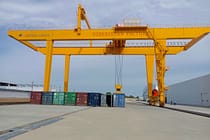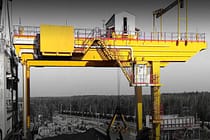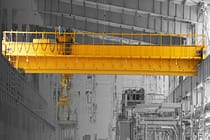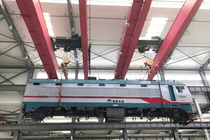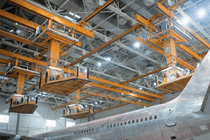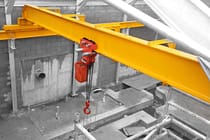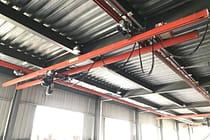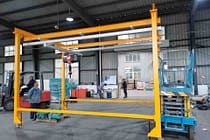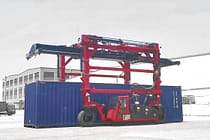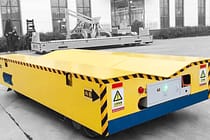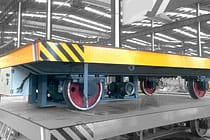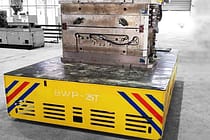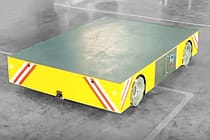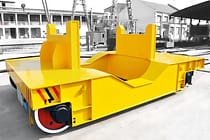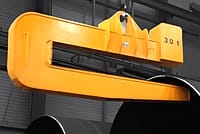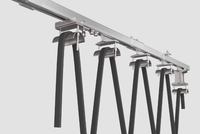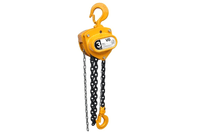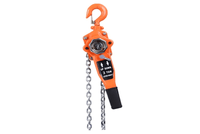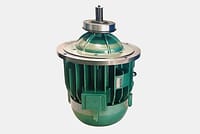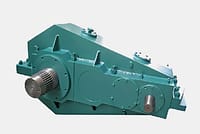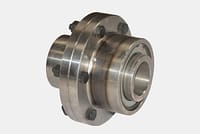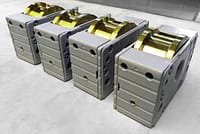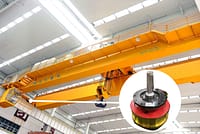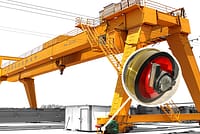Giàn Cẩu Nhà Xưởng: Chủng Loại Và Thông Số Kỹ Thuật
Cẩu trục là thiết bị nâng hạng nặng thường được sử dụng trong nhiều ngành công nghiệp khác nhau, chẳng hạn như xây dựng, sản xuất và hậu cần. Chúng là những cỗ máy đa năng có thể nâng và di chuyển các vật nặng một cách hiệu quả và an toàn. Trong bài viết này, chúng tôi sẽ thảo luận về các loại cẩu trục khác nhau có sẵn để sử dụng trong xưởng, thông số kỹ thuật của chúng và ưu điểm cũng như nhược điểm khi sử dụng chúng trong xưởng.
Cần trục bán cổng được sử dụng trong xưởng
Cần trục bán cổng là loại cần trục cổng có một đầu dầm được đỡ bằng chân hoặc cột, trong khi đầu còn lại tự do và có thể di chuyển dọc theo đường ray. Thiết kế này cho phép cần trục bán cổng nâng và di chuyển tải hiệu quả trong không gian hạn chế trong khi vẫn mang lại lợi ích của cần trục toàn cổng.

Thuận lợi
- Tiết kiệm không gian: Không giống như cần trục cổng đầy đủ, cần trục bán cổng chỉ cần một cấu trúc hỗ trợ, có thể là cấu trúc hiện có hoặc cột được xây dựng đặc biệt. Điều này có nghĩa là cần trục chiếm ít không gian hơn và cho phép nhiều không gian sàn hơn cho các hoạt động khác.
- Tiết kiệm chi phí: Cần trục bán cổng thường rẻ hơn cần trục cổng đầy đủ vì chúng cần ít vật liệu hơn để xây dựng. Ngoài ra, chi phí lắp đặt và bảo trì thấp hơn vì chỉ cần duy trì một cấu trúc hỗ trợ.
- Lắp đặt dễ dàng: Cần trục bán cổng dễ lắp đặt và quá trình lắp đặt có thể hoàn thành nhanh chóng. Vì chỉ cần một cấu trúc hỗ trợ nên thời gian lắp đặt được rút ngắn đáng kể so với cần trục cổng đầy đủ.
Nhược điểm
- Tính di chuyển hạn chế: Cẩu bán cổng được thiết kế để di chuyển theo một đường dẫn cố định, điều này hạn chế tính di chuyển của chúng trong xưởng.
- Công suất hạn chế: Công suất của cần trục bán cổng thường thấp hơn cần trục cổng đầy đủ vì chúng chỉ có một cấu trúc hỗ trợ. Điều này có nghĩa là chúng có thể không phù hợp để nâng tải cực nặng hoặc cho các ứng dụng yêu cầu chiều cao nâng cao hơn.
Thông số kỹ thuật
Nhìn chung, cần trục bán cổng có tải trọng lên đến 10 tấn, chiều dài nhịp lên đến 20m và nhóm nhiệm vụ A3-A5. Nếu bạn có nhu cầu khác, chúng tôi có thể cung cấp dịch vụ tùy chỉnh để sản xuất cần trục bán cổng đáp ứng nhu cầu của bạn.
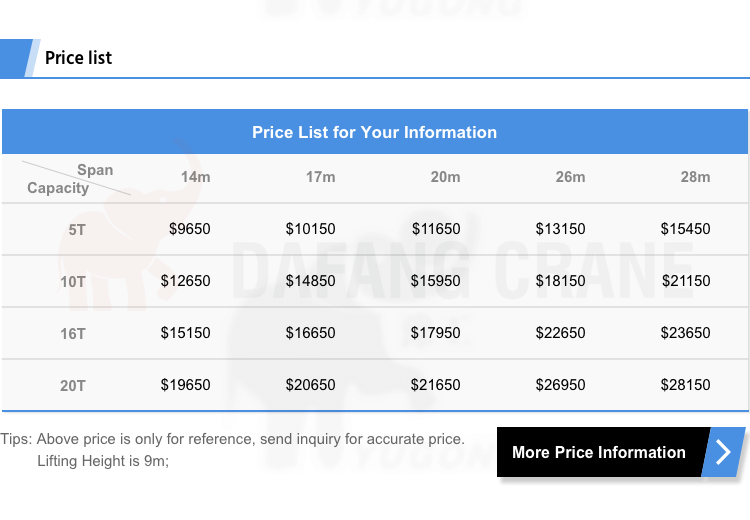
Cẩu giàn dầm đơn được sử dụng trong xưởng
Cẩu trục dầm đơn có một dầm đỡ hệ thống xe đẩy và tời. Chúng nhẹ và dễ lắp đặt, lý tưởng cho các xưởng nhỏ có không gian hạn chế. Cẩu trục dầm đơn cũng có chi phí sở hữu thấp hơn so với cẩu trục dầm đôi.
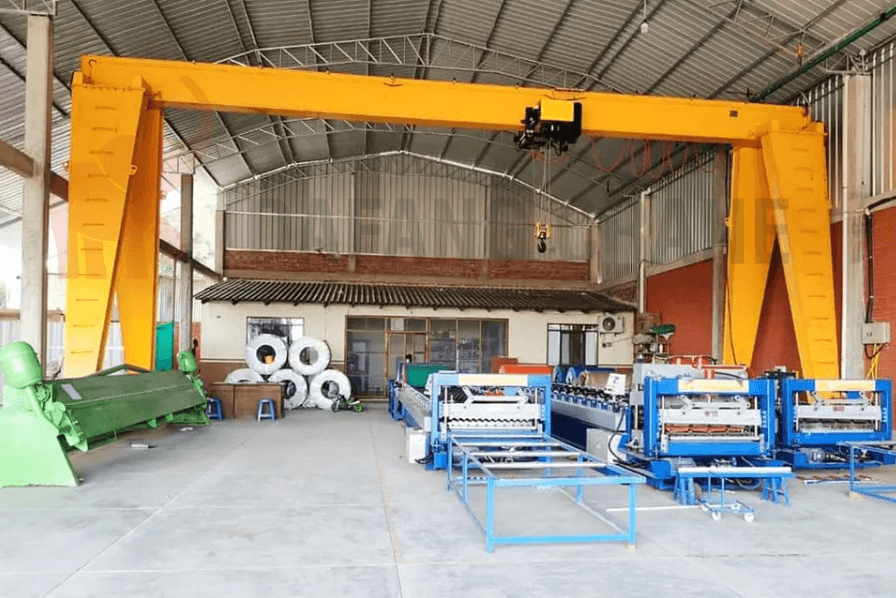
Thuận lợi
Cần trục dầm đơn cần ít vật liệu để sản xuất hơn so với cần trục dầm đôi, khiến chúng có giá cả phải chăng hơn và có khả năng chịu tải lớn hơn so với cần trục dầm nhỏ hơn. Chúng cũng dễ lắp đặt hơn, nghĩa là ít thời gian chết hơn cho doanh nghiệp của bạn trong quá trình lắp đặt. Cần trục dầm đơn cũng có thể được tùy chỉnh để phù hợp với các ứng dụng và yêu cầu cụ thể. Chúng linh hoạt và có thể được điều chỉnh để phù hợp với các nhu cầu nâng khác nhau.
Nhược điểm
Giới hạn về sức chứa của cần trục dầm đơn là một trong những nhược điểm chính của chúng. Chúng thường chỉ được khuyên dùng cho tải trọng lên đến 15 tấn vì chúng không thể xử lý tải trọng lớn. Ngoài ra, cần trục dầm đơn có thể không ổn định bằng cần trục dầm đôi. Do đó, khi nâng các vật lớn hơn, chúng có thể dễ bị lắc hoặc lật hơn.
Thông số kỹ thuật
Nhìn chung, cầu trục dầm đơn có tải trọng lên tới 50 tấn, chiều dài nhịp lên tới 50m và nhóm nhiệm vụ A3-A5.
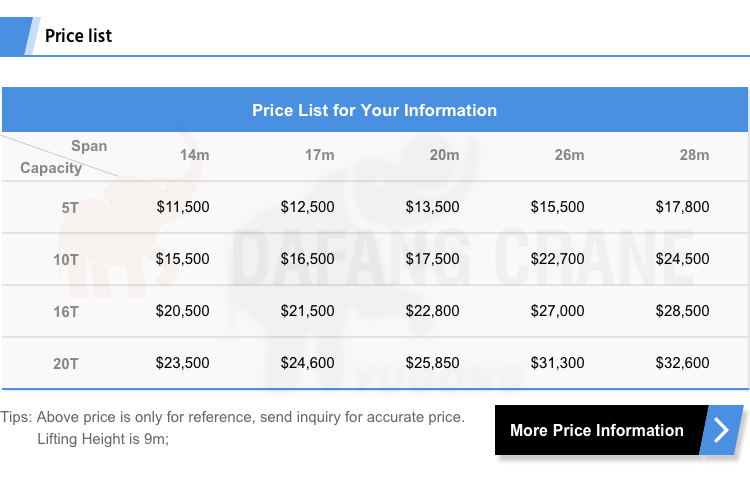
Cầu trục dầm đôi được sử dụng trong xưởng
Cơ cấu xe đẩy và tời được hỗ trợ bởi hai dầm dầm trong cần trục dầm đôi. Chúng ổn định hơn và được chế tạo để hỗ trợ tải trọng lớn hơn. Cần trục dầm đôi là lựa chọn tốt nhất cho các xưởng lớn cần nâng nhiều trọng lượng.

Thuận lợi
Một trong những ưu điểm quan trọng nhất của cần trục dầm đôi là khả năng chịu tải của chúng. Chúng có thể nâng tải nặng hơn so với các cần trục dầm đôi khác, khiến chúng phù hợp với các xưởng lớn có máy móc hạng nặng. Cần trục dầm đôi cũng ổn định hơn, giúp giảm nguy cơ tai nạn và tăng tính an toàn tại nơi làm việc. Chúng có thể được tùy chỉnh để phù hợp với các ứng dụng và yêu cầu cụ thể, đảm bảo hiệu suất và hiệu quả tối ưu.
Nhược điểm
Giá thành cao hơn của cần trục giàn đôi là một trong những nhược điểm chính của chúng. Chúng tốn kém hơn để sản xuất so với các cần trục giàn khác vì chúng cần nhiều vật liệu hơn. Ngoài ra, khó lắp đặt hơn, cần trục giàn đôi cần thời gian chết lâu hơn. Chúng cũng kém linh hoạt hơn so với các cần trục giàn khác và có thể không phù hợp với các xưởng nhỏ có không gian hạn chế.
Thông số kỹ thuật
Nhìn chung, cần trục dầm đôi có tải trọng lên tới 800 tấn, chiều dài nhịp lên tới 100m và nhóm nhiệm vụ A3-A7.
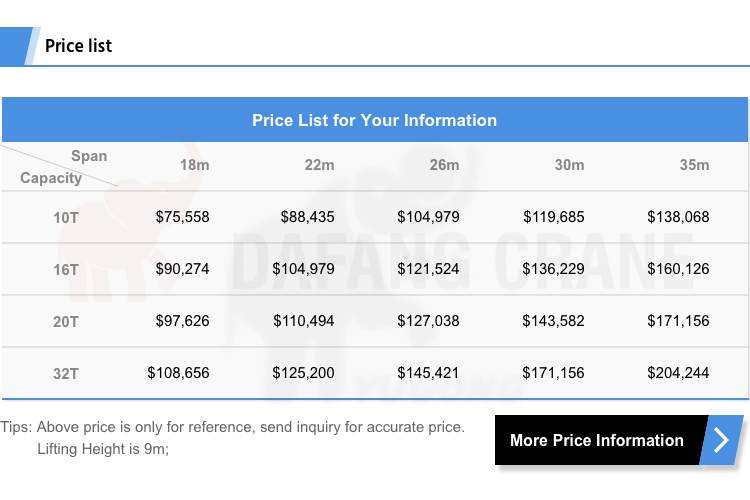
Cẩu di động dùng trong xưởng
Cẩu giàn di động là giải pháp lý tưởng để nâng và di chuyển các vật nặng trong xưởng. Chúng linh hoạt, dễ di chuyển và có thể lắp đặt nhanh chóng mà không cần lắp đặt cố định.
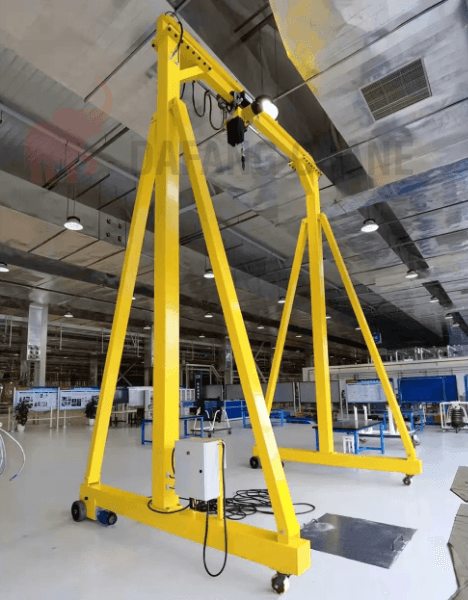
Thuận lợi
- Đa năng: Một trong những lợi thế lớn nhất của cần trục di động là tính linh hoạt của chúng. Những cần trục này có thể được sử dụng để nâng và di chuyển các vật nặng ở nhiều vị trí khác nhau trong xưởng. Chúng có thể dễ dàng di chuyển từ vị trí này sang vị trí khác, khiến chúng trở thành lựa chọn lý tưởng cho các xưởng có không gian hạn chế.
- Tiết kiệm chi phí: So với các loại cần cẩu khác, cần cẩu giàn di động có giá thành tương đối rẻ. Đây là lựa chọn tiết kiệm chi phí cho các xưởng cần cần cẩu nhưng không có đủ ngân sách cho lựa chọn đắt tiền hơn.
- Dấu chân nhỏ: Vì cần trục cổng di động không yêu cầu lắp đặt cố định nên chúng có dấu chân nhỏ. Điều này có nghĩa là chúng chiếm ít không gian hơn trong xưởng và có thể dễ dàng cất giữ khi không sử dụng.
Nhược điểm
- Khả năng nâng hạn chế: Cần trục cổng di động có khả năng nâng hạn chế so với các loại cần trục khác. Chúng thường được thiết kế để nâng tải trọng lên đến 5 tấn, có thể không đủ cho một số ứng dụng hạng nặng.
- Chiều cao hạn chế: Cần trục di động có phạm vi chiều cao hạn chế, có thể là bất lợi trong một số trường hợp. Chúng có thể không nâng được vật lên độ cao cần thiết trong các xưởng cao hơn.
- Các vấn đề về độ ổn định: Cần trục cổng di động có thể kém ổn định hơn các loại cần trục khác, đặc biệt là khi sử dụng trên bề mặt không bằng phẳng hoặc mềm. Điều này có thể gây ra rủi ro an toàn nếu cần trục bị lật khi nâng vật nặng.
Thông số kỹ thuật
Nhìn chung, cần trục di động có tải trọng lên tới 10 tấn, chiều dài nhịp lên tới 10m và nhóm nhiệm vụ A3-A5.
Cần trục cổng điều chỉnh được sử dụng trong xưởng
Cẩu trục điều chỉnh được là loại cẩu trục có thể điều chỉnh chiều cao và nhịp, khi sử dụng trong môi trường xưởng, chúng mang lại sự linh hoạt và đa năng hơn.
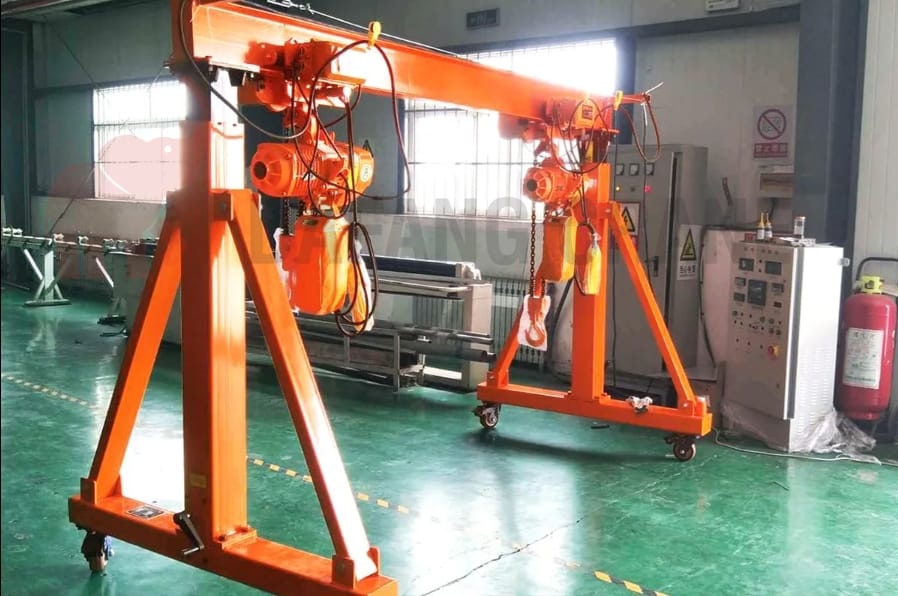
Thuận lợi
- Chiều cao và khoảng cách có thể tùy chỉnh: Một trong những lợi thế lớn nhất của cần trục cổng có thể điều chỉnh là khả năng tùy chỉnh theo nhu cầu của xưởng. Chiều cao và khoảng cách của cần trục có thể được điều chỉnh để đáp ứng các yêu cầu nâng khác nhau. Điều này làm cho chúng linh hoạt và có thể xử lý nhiều loại vật liệu.
- Dễ di chuyển: Một lợi thế khác của cần trục cổng điều chỉnh là tính di động của chúng. Chúng được thiết kế với bánh xe giúp dễ dàng di chuyển xung quanh sàn xưởng. Điều này có nghĩa là chúng có thể được đặt ở bất cứ nơi nào cần thiết, giúp việc xử lý vật liệu hiệu quả hơn.
- Tiết kiệm chi phí: Cuối cùng, cần trục cổng điều chỉnh tiết kiệm chi phí hơn so với các loại cần trục khác. Chúng đòi hỏi ít đầu tư ban đầu hơn và dễ bảo trì hơn theo thời gian. Chúng cũng linh hoạt hơn, nghĩa là một cần trục có thể xử lý nhiều loại vật liệu hơn, giảm nhu cầu sử dụng nhiều loại cần trục.
Nhược điểm
- Khả năng nâng hạn chế: Một nhược điểm của cần trục cổng điều chỉnh là khả năng nâng hạn chế. Mặc dù chúng phù hợp với các vật liệu có kích thước nhỏ đến trung bình, nhưng chúng có thể không có khả năng nâng các vật nặng hơn. Điều này hạn chế tính hữu ích của chúng trong các xưởng lớn hơn.
- Tầm với hạn chế: Một nhược điểm khác của cần trục cổng điều chỉnh là tầm với hạn chế. Chúng được thiết kế để sử dụng trong một khu vực cụ thể và có thể không thể tiếp cận một số phần nhất định của xưởng. Điều này có thể khiến chúng ít hữu ích hơn ở những không gian lớn hơn.
- Độ bền hạn chế: Cuối cùng, cần trục cổng điều chỉnh có thể có độ bền hạn chế theo thời gian. Điều này là do thiết kế nhẹ của chúng, khiến chúng dễ bị hao mòn. Chúng có thể cần được thay thế thường xuyên hơn các loại cần trục khác.
Thông số kỹ thuật
Nhìn chung, cần trục cổng điều chỉnh có tải trọng lên tới 10 tấn, chiều dài nhịp lên tới 10m và nhóm nhiệm vụ A3-A5.
Cần trục cổng xưởng là giải pháp nâng hạ thiết yếu cho bất kỳ xưởng hoặc nhà máy nào cần di chuyển tải trọng nặng một cách nhanh chóng và hiệu quả. Bằng cách hiểu các loại và thông số kỹ thuật khác nhau của cần trục cổng xưởng, bạn có thể chọn loại phù hợp với yêu cầu nâng hạ cụ thể của mình.
gửi yêu cầu của bạn
- E-mail: sales@hndfcrane.com
- WhatsApp: +86 191 3738 6654
- Điện tín: +86 191 3738 6654
- ĐT: +86-373-581 8299
- Fax: +86-373-215 7000
- Địa chỉ: Khu công nghiệp Changnao, thành phố Tân Hương, tỉnh Hà Nam, Trung Quốc
 WeChat
WeChat








